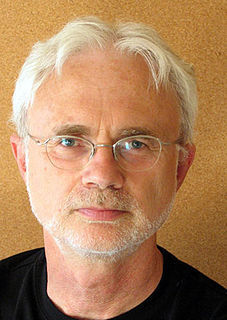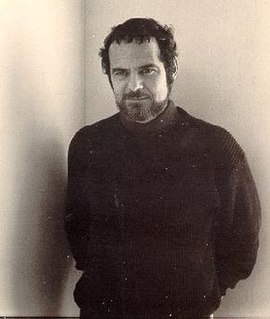Related Research Articles

John Coolidge Adams is an American composer and conductor whose music is rooted in minimalism. Among the most regularly performed composers of contemporary classical music, he is particularly noted for his operas, which are often centered around recent historical events. Apart from opera, his oeuvre includes orchestral, concertante, vocal, choral, chamber, electroacoustic and piano music.

Philip Morris Glass is an American composer and pianist. He is widely regarded as one of the most influential composers of the late 20th century. Glass's work has been associated with minimalism, being built up from repetitive phrases and shifting layers. Glass describes himself as a composer of "music with repetitive structures", which he has helped evolve stylistically.
Joan Tower is a Grammy-winning contemporary American composer, concert pianist and conductor. Lauded by The New Yorker as "one of the most successful woman composers of all time", her bold and energetic compositions have been performed in concert halls around the world. After gaining recognition for her first orchestral composition, Sequoia (1981), a tone poem which structurally depicts a giant tree from trunk to needles, she has gone on to compose a variety of instrumental works including Fanfare for the Uncommon Woman, which is something of a response to Aaron Copland's Fanfare for the Common Man, the Island Prelude, five string quartets, and an assortment of other tone poems. Tower was pianist and founding member of the Naumburg Award-winning Da Capo Chamber Players, which commissioned and premiered many of her early works, including her widely performed Petroushskates.

In the South (Alassio), Op. 50, is a concert overture composed by Edward Elgar during a family holiday in Italy in the winter of 1903 to 1904. He was working on a symphony, but the local atmosphere inspired him instead to write what some have seen as a tone poem, with an Italian flavour. At about 20 minutes' duration it was the composer's longest sustained orchestral piece to that time.

Stephen Joel Albert was an American composer. He is best known for his Symphony No. 1 RiverRun (1983) and Cello Concerto (1990) written for Yo-Yo Ma, both of which won a Pulitzer Prize for Music. He died suddenly in a 1992 automobile accident, having just sketched out his Second Symphony. The work was subsequently completed by Sebastian Currier, and his death sparked musical tributes from composer colleagues such as Aaron Jay Kernis and Christopher Rouse.
The Boston Modern Orchestra Project (BMOP) is a professional orchestra in Boston, Massachusetts, United States.
Jeu de timbres is a single-movement orchestral composition by the American composer Steven Stucky. The work was commissioned by the National Symphony Orchestra and completed in late 2003. It was premiered in January 2004, with the National Symphony Orchestra performing under conductor Leonard Slatkin.
Son et lumière is a symphonic poem by the American composer Steven Stucky. It was commissioned by the Baltimore Symphony Orchestra and composed between June and December 1988. The work was premiered in Baltimore by the Baltimore Symphony Orchestra under conductor David Zinman, May 18, 1989.
The Concerto for Orchestra is an orchestral composition in five movements by the American composer Jennifer Higdon. The work was commissioned by the Philadelphia Orchestra with contributions from the National Endowment for the Arts, the Philadelphia Music Project, and Peter Benoliel. It was premiered at the Kimmel Center for the Performing Arts in Philadelphia June 12, 2002, with conductor Wolfgang Sawallisch leading the Philadelphia Orchestra.
Seeing is a concerto for solo piano and orchestra by the American composer Christopher Rouse. The work was commissioned by the New York Philharmonic for the pianist Emanuel Ax, with financial contributions from philanthropists Lillian and Maurice Barbash. It was premiered at Avery Fisher Hall in New York City May 6, 1999, with Leonard Slatkin conducting Emanuel Ax and the New York Philharmonic. The piece is dedicated to Emanuel Ax.
Fanfare Ritmico is a single-movement orchestral composition by the American composer Jennifer Higdon. The work was commissioned by The Women's Philharmonic as part of The Fanfares Project. It was given its world premiere in March 2000 by conductor Apo Hsu and the Women's Philharmonic.
My Beautiful Scream is a concerto for amplified string quartet and orchestra by the American composer Julia Wolfe. The work was jointly commissioned by Radio France, the Basel Sinfonietta, and the Brooklyn Philharmonic for the Kronos Quartet. It was first performed on February 6, 2004 at the Festival Presence in Paris by the Orchestre Philharmonique de Radio France and the Kronos Quartet.
Stroke is an orchestral composition by the American composer Joan Tower. The work was commissioned by the Pittsburgh Symphony Orchestra and is dedicated to the composer's brother, who suffered from a debilitating stroke in 2008. It was first performed in Pittsburgh on May 13, 2011, by the Pittsburgh Symphony Orchestra under the conductor Manfred Honeck.
The Concerto for Orchestra is an orchestral composition by the American composer Joan Tower. The work was jointly commissioned by the St. Louis Symphony, the Chicago Symphony Orchestra, and the New York Philharmonic.
The Concerto for Clarinet is a composition for solo clarinet and orchestra by the American composer Joan Tower. The work was commissioned by the Walter W. Naumburg Foundation for the clarinetist Charles Neidich, to whom the piece is dedicated.
Sequoia is an orchestral composition by the American composer Joan Tower. The work was commissioned by the American Composers Orchestra with support from the Jerome Foundation. It was first performed on May 18, 1981, in Alice Tully Hall by the American Composers Orchestra under the conductor Dennis Russell Davies. The piece is dedicated to the concertmistress and first horn player of the orchestra, Jean and Paul Ingraham, respectively. Sequoia was Tower's first major orchestral composition and remains one of the composer's most performed works.
Purple Rhapsody is a viola concerto by the American composer Joan Tower. The work was jointly commissioned by the Omaha Symphony Orchestra with the Buffalo Philharmonic Orchestra, the Virginia Symphony Orchestra, the Kansas City Symphony, the ProMusica Chamber Orchestra, Peninsula Music Festival Orchestra, and the Chautauqua Symphony Orchestra with a grant from the Serge Koussevitzky Music Foundation in the Library of Congress. It was first performed on November 4, 2005, by the Omaha Symphony Orchestra and the violist Paul Neubauer, to whom the piece is dedicated.
Tambor is an orchestral composition in one movement by the American composer Joan Tower. The work was commissioned by the Pittsburgh Symphony Orchestra and was composed between September 1997 and February 1998. It was first performed on May 7, 1998, by the Pittsburgh Symphony Orchestra under the conductor Mariss Jansons. The piece is dedicated Robert Moir, then artistic director for the Pittsburgh Symphony Orchestra.
Phaethon is a symphonic poem by the American composer Christopher Rouse. The work was commissioned in celebration of the United States Bicentennial by the Philadelphia Orchestra with contributions from Johnson & Higgins. It was completed on February 22, 1986, and was given its world premiere at the Academy of Music in Philadelphia by the Philadelphia Orchestra under the direction of Riccardo Muti on January 8, 1987. It is dedicated in memory of the crew of the Space Shuttle Challenger, which broke apart on the morning of January 28, 1986 while Rouse was composing the piece. Since its premiere, Phaethon has become one of Rouse's most popular orchestral compositions.
Eros Piano is a piano concerto written by the American minimalist composer John Adams. The work was commissioned by the Koussevitzky Music Foundation in 1984 and was completed in 1989. Its world premiere was performed by the pianist Paul Crossley and the London Sinfonietta conducted by Adams on November 24, 1989, in Queen Elizabeth Hall, London. The piece is dedicated to Paul Crossley. It is the first of three piano concertos by Adams, followed by Century Rolls in 1996 and Must the Devil Have All the Good Tunes? in 2019.
References
- 1 2 3 Tower, Joan (2004). "Made in America". G. Schirmer Inc. Retrieved January 18, 2016.
- ↑ Oteri, Frank J. (October 1, 2005). "Joan Tower: Made in America". NewMusicBox . Retrieved January 18, 2016.
- ↑ Kozinn, Allan (February 7, 2006). "A Celebration of America, With the Future in Question". The New York Times . Retrieved January 18, 2016.
- ↑ Huizenga, Tom (February 11, 2008). "'Made in America,' from Coast to Coast". NPR . Retrieved January 18, 2016.